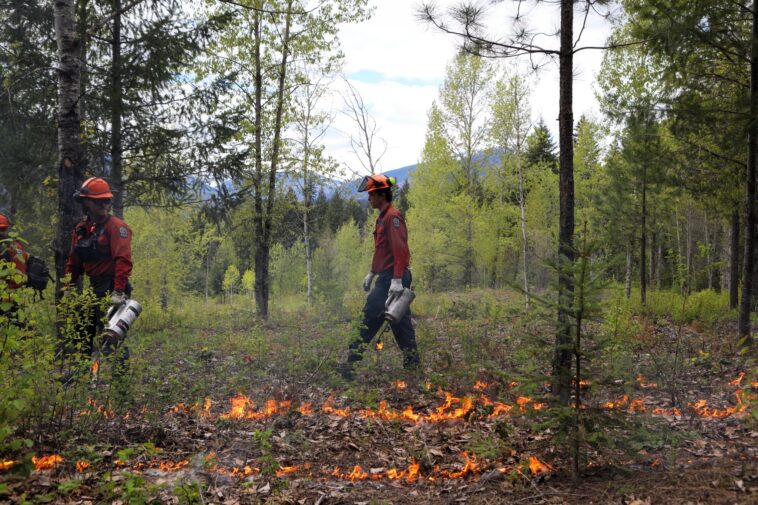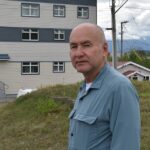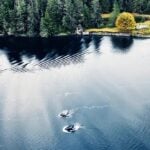After fuelling up their drip torches, BC Wildfire Service (BCWFS) workers wearing red jackets begin to lay fire to an area of dry forest ground in Nlaka’pamux territory.
Donning helmets and gloves, the crew members walk side-by-side in straight lines through the dense woodland area around them, slowly running their torches through vegetation and surface debris near their feet. They leave trails of fire behind them as they trudge along.

The controlled burn on May 2 was conducted in partnership between the Boothroyd Indian Band and BCWFS on band land, located near “Boston Bar,” just across from the entrance to the community, with Highway 1 dividing the two.
The project was designed to help build on the Nlaka’pamux community’s knowledge of fire and the ecosystem, as well as to improve their confidence in mitigating wildfires. Fifteen BCWFS members trained six young contract firefighters from Boothroyd on how to conduct a prescribed burn.

The community itself has an extensive and long history of conducting their own cultural burns. Their wildfire mitigation treatment consists of trimming trees; removing debris; piling it all together and burning.
“I think it’s long overdue.”
Rick Campbell, elder and former band chief
Elder and former band chief Rick Campbell estimated that the practice of cultural and prescribed burns hasn’t been done in some areas throughout the nation for at least 500 years.
“I think it’s long overdue,” he said.
‘We want to provide protection’

It’s a bit of a hike up to the 14-hectare burn project, which is located on a 55-hectare wildfire treatment plot. Plans for the burn have been in the works for two seasons. The area was identified for fuel mitigation treatment to help create a greater buffer distance between the forest and the nearby Boothroyd community in case of wildfire.

Within minutes, thick smoke consumes the open spaces between the trees, resulting in a ghostly fog that’s rough on the lungs when inhaled.
The smell of burning surface fuel clouds the air, as the firefighters continue to descend down the burn zone and graze untreated grounds with their torches.

The fire spreads, and the rows of flames grow longer, with some of the trails merging together to become patches. Parts of the land are scarred with burns.
Surrounding the controlled burn’s perimeter are crew members equipped with axes, fire rakes and other suppression tools, carefully monitoring the fire’s behaviour. They’re there to contain the burn within its designated sector, tending to the flames and ready to extinguish any that burn out of control.

Cultural and prescribed burns are low-intensity, controlled burns that are designed to eliminate surface fuels on a forest floor to mitigate the spread of wildfire if it passes through an area. They are typically carried out before or after the wildfire season.
In addition to being a wildfire mitigation treatment project, another goal of this particular burn was to help replenish the land and re-introduce fire to the ecosystem in a healthy way. The cultural objective of the burn was to restore the health of medicinal plants and food sources in the area, while clearing the forest of dead debris and pushing back on invasive species.

“We want to create an alleyway between our natural occurring forest and where people live in the community. We want to provide protection for them.”
Trevor Moore, crew leader on the Trailblazer Unit Crew for BCWFS
“The idea behind the project is that we want to create a bit of protection for the community. With wildfires in the area in the last few years, there’s been a lot of stress around the wildfire situation,” said Trevor Moore, the crew leader on the Trailblazer Unit Crew for BCWFS.
“We want to create an alleyway between our natural occurring forest and where people live in the community. We want to provide protection for them.”
‘It goes a long way’

The Boothroyd area and surrounding Nlaka’pamux communities have grappled with devastating wildfires in the last three years. In 2021, the nearby village of Lytton — which is about a half-hour drive from Boothroyd — was destroyed by fire, displacing the entire community.

Last summer, the Kookipi Creek wildfire forced several Nlaka’pamux communities — including members from Boothroyd — to evacuate from their homes. Elder Rick said that the fire grew so fast that it forced people to leave quickly.
“That was pretty scary for a lot of the community members. We’ve never been evacuated before,” he said.

For 19-year-old Gage Campbell, he recalled feeling helpless and wanting to stay back to help fight the blaze.
In response to the fast-moving fire, the community assembled a crew of contract wildfire fighters to assist with suppressing the threat, and Gage jumped at the opportunity to return and help out.
“After I started working and was able to come home, it was more of a rewarding feeling,” he said. “I felt happy to be out there doing something.”

One year later, Gage remains a contract firefighter for Boothroyd Indian Band and is now the community’s firesmart coordinator.
“I feel honoured that they trust me to be in this position,” he said.
According to BCWFS, there were a total of 58 prescribed and cultural burn projects throughout the province in 2022 and 2023, with more than 3,800 hectares treated. Of those 58 projects, 38 of them were developed or co-developed with Indigenous communities. This year, there are 61 burn projects in the works, according to the province.
Elder Rick said that the Kookipi Creek wildfire last year “opened a lot of eyes” when it destroyed a significant site where mushrooms and other medicinal plants are harvested.
George Campbell, a Boothroyd Band member and wildfire officer for the Fraser Fire Zone for BCWFS’s Coastal Fire Centre, said that introducing fire back into the landscape in a controlled manner can earn a lot of trust from the community.
‘A good fire’

“It enables us to work and collaborate with them. It means a lot, and it goes a long way,” he said.
Before treatment was underway, Gage expressed an eagerness to learn about how the fire starts, ends and is maintained.
“I’m excited to get my hands on a drip torch and get out there and see what it’s like,” he said.
“I only have that one year of contracting fighting experience. I’m excited to see more.”

George said that the remaining untreated area will be cared for next year.
“This is meant to be a good fire, versus a wildfire.”
George Campbell, Boothroyd Band member and wildfire officer for the Fraser Fire Zone for BCWFS’s Coastal Fire Centre
“We want to put this front and centre for the community of Boothroyd, just so we can earn that trust and promote that fire can be good in certain situations like this,” he said.
“This is meant to be a good fire, versus a wildfire.”
Moore said that he was thrilled to assist the group of Boothroyd fire crews with adding the practice of prescribed burns to their toolkit.
“To allow them to manage their own land once again, as they have in the past, is very exciting for the future,” he said.
“What we’re trying to add to them is the tool of prescribed fire, on top of what they already know.”
Story by Aaron Hemens, Local Journalism Initiative Reporter / IndigiNews




